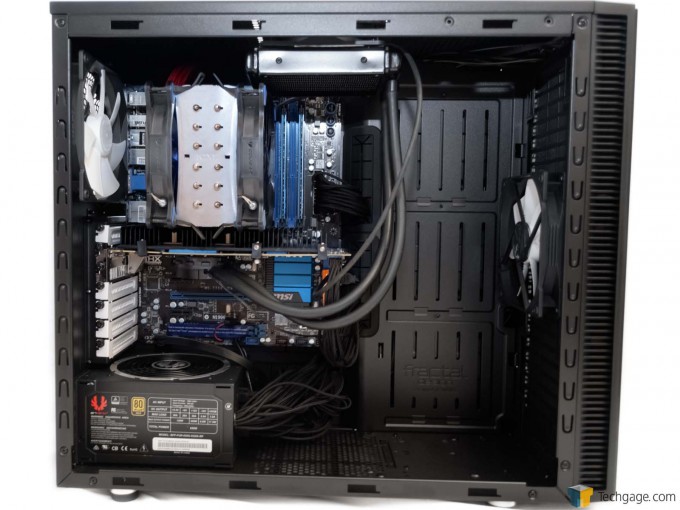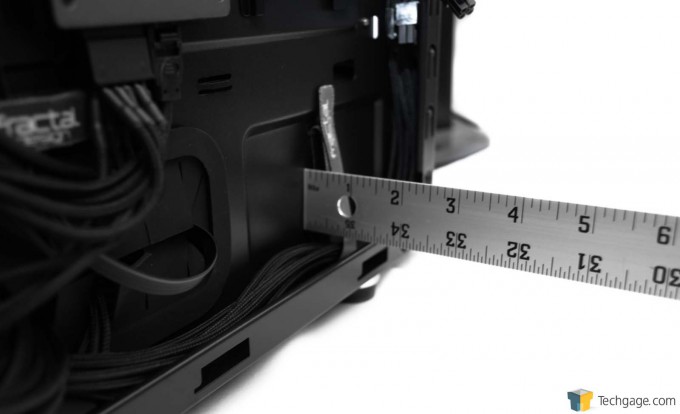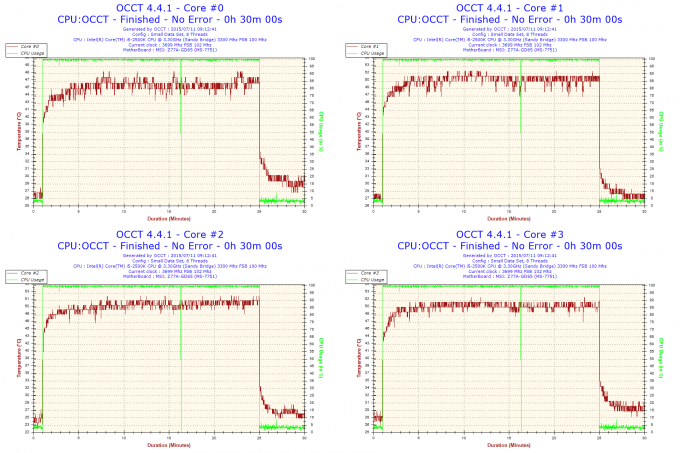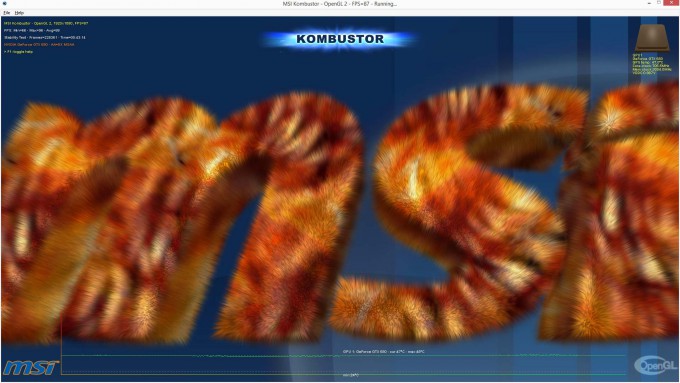- Qualcomm Launches Snapdragon 4 Gen 2 Mobile Platform
- AMD Launches Ryzen PRO 7000 Series Mobile & Desktop Platform
- Intel Launches Sleek Single-Slot Arc Pro A60 Workstation Graphics Card
- NVIDIA Announces Latest Ada Lovelace Additions: GeForce RTX 4060 Ti & RTX 4060
- Maxon Redshift With AMD Radeon GPU Rendering Support Now Available
The PC Chassis Evolved – A Review Of The Fractal Design Define S
It’s not often when we get to see PC chassis designs evolve. Generally speaking, they’re all pretty much the same, sharing all of the same features. So when we get something like the Fractal Design Define S, which boasts a feature no other chassis does, we sit up and pay attention. Join us as we take one on a Techgage test drive.
Page 2 – Installation & Performance Testing
I’ll be reviewing the Fractal Design Define S on a few key criteria: ease of system installation; cooling performance; a subjective evaluation of its noise output characteristics; and a few miscellaneous comments about the chassis’ build quality.
First, though, a look at our test system’s components:
| Chassis Test System | |
| Processor | Intel Core i5 2500K @ 3.3GHz/1.2V VCore |
| Motherboard | MSI Z77A-GD65 |
| Memory | Patriot PSD38G1333KH 2 x 4GB DDR3 |
| Graphics | EVGA NVIDIA GeForce GTX 680 (Reference design) |
| Audio | Onboard |
| Storage | Crucial C300 (128GB) SSD |
| Power Supply | BitFenix Fury 650G |
| Chassis | Fractal Design Define S |
| CPU Cooling | NZXT Havik 140 |
| GPU Cooling | Arctic Accelero Hybrid II-120 |
| OS | Windows 8.1 64-bit |
And here’s a look at how everything looks in the Fractal Design Define S:
The Fractal Design Define S is one the easiest chassis to install a system in. It took me about forty minutes to put everything in this beautifully designed tower.
This might be the best chassis I’ve ever tested in terms of ease in cable management. The openings in the motherboard tray are both well-positioned and large enough to make threading all the various cables very easy. And this is a quick and dirty job at cable management; all it would take to make it neater is more planning and time. (Because all of these builds get torn down right after for the next chassis review, I never go all-out in managing the cables.)
The 1.5″ gap between the rear of the motherboard tray and the side panel aids in the ease of cable management. Even the thickest bundles of cables will fit within that space. Not only that, but Fractal Design has equipped the Define S with high-tech velcro so that you can rein in those bundles of cables with ease. And if that’s not enough, don’t forget to use the zip-ties included in the accessories package.
Moving on to thermal testing, I will use the OCCT CPU stability test program to generate maximum CPU load and temperatures as well as MSI Kombustor for the GPU temperature testing. Ambient temperature will be kept constant at 72°F/22.2°C.
A preliminary note about thermal testing: A PC chassis being reviewed ought to be in as close to stock configuration as possible. That means I won’t add fans to the system (other than what comes with certain components’ cooling systems). Also, per my now routine practice, I’ll also use the same torture tests to put the CPU and the GPU under maximum load conditions. OCCT is the torture test of choice for the CPU, while MSI Kombustor fits the bill for the GPU.
So this is how the Define S fared:
Across the four cores of the i5-2500K, the maximum temperatures registered were 47°/50°/51°/51°C. The following table shows how this performance compares to other chassis I’ve tested with the test system in an identical configuration:
| Chassis | Maximum Core Temperatures Recorded |
| Danger Den Torture Rack | 50°/54°/54°/55° C |
| Corsair Obsidian 450D | 49°/52°/51°/51° C |
| Puget Systems Test Bench | 51°/54°/54°/54° C |
| Corsair Graphite 730T | 48°/52°/52°/52° C |
| Lian Li PC-A61 | 48°/51°/52°/52° C |
| Thermaltake Core V51 | 50°/52°/51°/51° C |
| Corsair Graphite 780T | 48°/51°/51°/51° C |
| In Win 707 | 49°/52°/52°/52° C |
| Supermicro S5 | 47°/51°/51°/51° C |
| Fractal Design Define S | 47°/51°/51°/51° C |
The Define S gives nothing away to its competition, tying the Supermicro S5 as the best performer in the CPU maximum temperature tests.
But how does it do in the maximum GPU temperature test?
MSI Kombustor makes the test system’s GPU hit a peak of 48°C. That is, by far, the best performance I’ve seen yet from all chassis I’ve tested. I thought that open test benches held an inherent advantage in this kind of test; the Define S, for some reason, outperforms even the best open test bench result by two degrees Centigrade.
I actually did this test a couple of times, just to make sure the results were consistent. Sure enough, at the same ambient temperature, the test GPU hit the same peak temperature every single time I ran the test. And I made sure to shut down the system so I can run the test from cold.
Here is the table showing how the Define S compares to every chassis I’ve run this same test with so far:
| Chassis | Maximum GPU Temperatures Recorded |
| Danger Den Torture Rack | 55° C |
| Corsair Obsidian 450D | 63° C |
| Puget Systems Test Bench | 50° C |
| BitFenix Neos | 68° C |
| Corsair Graphite 730T | 57° C |
| Lian Li PC-A61 | 52° C |
| Thermaltake Core V51 | 74° C |
| Corsair Graphite 780T | 52° C |
| In Win 707 | 74° C |
| Supermicro S5 | 70° C |
| Fractal Design Define S | 48° C |
Pretty cool stuff from Fractal Design, I must say.
In terms of noise output, the Define S practically defines silent operation. Even with the test system on the workbench a mere couple of feet away from my ears, I couldn’t hear either the chassis fans or the ones mounted on the CPU and GPU coolers. The Define S soaks up all noise and vibration, making it a great choice for silent PC enthusiasts.
Closing up this section of the testing, the Define S’ build quality ranks among the best I’ve seen. The paint is blemish free, and the power and reset buttons have a high-quality feel about them. The tolerances of the various screws – the side panel thumbscrews and the standoffs, for example – also evoke the same high-quality feel. The quality of the plastic is also most impressive; you never get the sense that the plastic bits are brittle or susceptible to damage. The chassis structure feels as solid as an M1 Abrams. The funny thing is, as indestructible as it feels, you’d expect the Define S to weigh as much as an M1 Abrams. Somehow it’s not that heavy. Fractal Design uses steel, not aluminum, as the primary material of the chassis, so it’s somewhat amazing that the Define S won’t break your back as you move it about.
Let’s finish things up.
Support our efforts! With ad revenue at an all-time low for written websites, we're relying more than ever on reader support to help us continue putting so much effort into this type of content. You can support us by becoming a Patron, or by using our Amazon shopping affiliate links listed through our articles. Thanks for your support!








